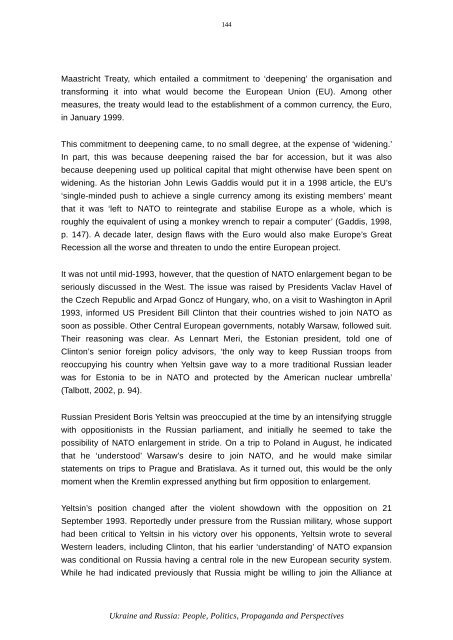Ukraine-and-Russia-E-IR
Ukraine-and-Russia-E-IR
Ukraine-and-Russia-E-IR
You also want an ePaper? Increase the reach of your titles
YUMPU automatically turns print PDFs into web optimized ePapers that Google loves.
144<br />
Maastricht Treaty, which entailed a commitment to ‘deepening’ the organisation <strong>and</strong><br />
transforming it into what would become the European Union (EU). Among other<br />
measures, the treaty would lead to the establishment of a common currency, the Euro,<br />
in January 1999.<br />
This commitment to deepening came, to no small degree, at the expense of ‘widening.’<br />
In part, this was because deepening raised the bar for accession, but it was also<br />
because deepening used up political capital that might otherwise have been spent on<br />
widening. As the historian John Lewis Gaddis would put it in a 1998 article, the EU’s<br />
‘single-minded push to achieve a single currency among its existing members’ meant<br />
that it was ‘left to NATO to reintegrate <strong>and</strong> stabilise Europe as a whole, which is<br />
roughly the equivalent of using a monkey wrench to repair a computer’ (Gaddis, 1998,<br />
p. 147). A decade later, design flaws with the Euro would also make Europe’s Great<br />
Recession all the worse <strong>and</strong> threaten to undo the entire European project.<br />
It was not until mid-1993, however, that the question of NATO enlargement began to be<br />
seriously discussed in the West. The issue was raised by Presidents Vaclav Havel of<br />
the Czech Republic <strong>and</strong> Arpad Goncz of Hungary, who, on a visit to Washington in April<br />
1993, informed US President Bill Clinton that their countries wished to join NATO as<br />
soon as possible. Other Central European governments, notably Warsaw, followed suit.<br />
Their reasoning was clear. As Lennart Meri, the Estonian president, told one of<br />
Clinton’s senior foreign policy advisors, ‘the only way to keep <strong>Russia</strong>n troops from<br />
reoccupying his country when Yeltsin gave way to a more traditional <strong>Russia</strong>n leader<br />
was for Estonia to be in NATO <strong>and</strong> protected by the American nuclear umbrella’<br />
(Talbott, 2002, p. 94).<br />
<strong>Russia</strong>n President Boris Yeltsin was preoccupied at the time by an intensifying struggle<br />
with oppositionists in the <strong>Russia</strong>n parliament, <strong>and</strong> initially he seemed to take the<br />
possibility of NATO enlargement in stride. On a trip to Pol<strong>and</strong> in August, he indicated<br />
that he ‘understood’ Warsaw’s desire to join NATO, <strong>and</strong> he would make similar<br />
statements on trips to Prague <strong>and</strong> Bratislava. As it turned out, this would be the only<br />
moment when the Kremlin expressed anything but firm opposition to enlargement.<br />
Yeltsin’s position changed after the violent showdown with the opposition on 21<br />
September 1993. Reportedly under pressure from the <strong>Russia</strong>n military, whose support<br />
had been critical to Yeltsin in his victory over his opponents, Yeltsin wrote to several<br />
Western leaders, including Clinton, that his earlier ‘underst<strong>and</strong>ing’ of NATO expansion<br />
was conditional on <strong>Russia</strong> having a central role in the new European security system.<br />
While he had indicated previously that <strong>Russia</strong> might be willing to join the Alliance at<br />
<strong>Ukraine</strong> <strong>and</strong> <strong>Russia</strong>: People, Politics, Propag<strong>and</strong>a <strong>and</strong> Perspectives


